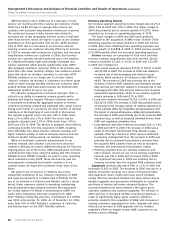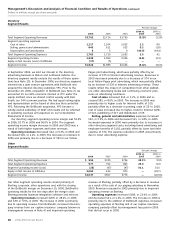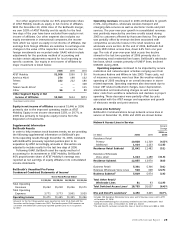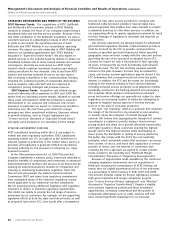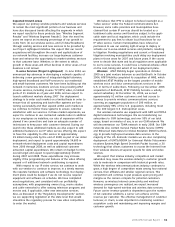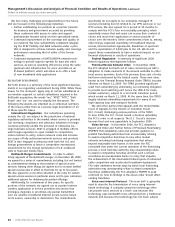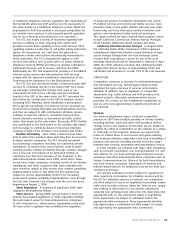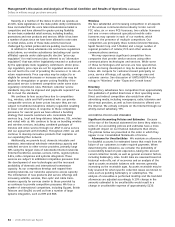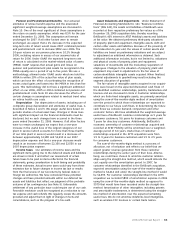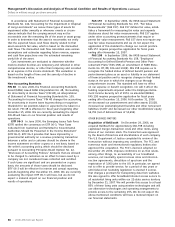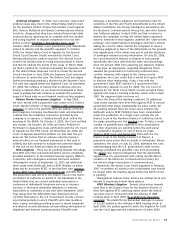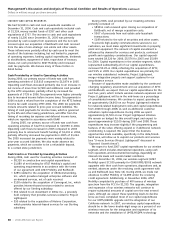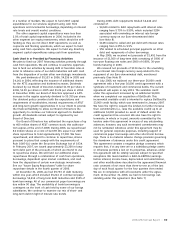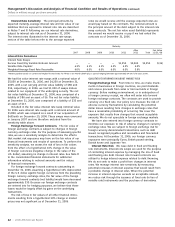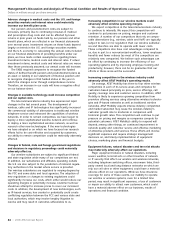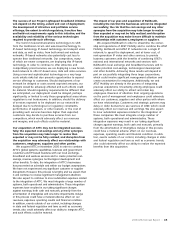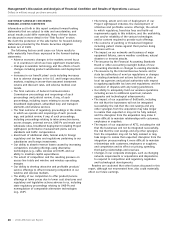AT&T Wireless 2006 Annual Report Download - page 38
Download and view the complete annual report
Please find page 38 of the 2006 AT&T Wireless annual report below. You can navigate through the pages in the report by either clicking on the pages listed below, or by using the keyword search tool below to find specific information within the annual report.
36 : :
2006 AT&T Annual Report
Management’s Discussion and Analysis of Financial Condition and Results of Operations (continued)
Dollars in millions except per share amounts
In accordance with Statement of Financial Accounting
Standards No. 144, “Accounting for the Impairment or Disposal
of Long-Lived Assets,” we review these types of assets for
impairment either annually or whenever events or circum-
stances indicate that the carrying amount may not be
recoverable over the remaining life of the asset or asset group.
In order to determine that the asset is recoverable, we verify
that the expected future cash flows directly related to that
asset exceed its fair value, which is based on the discounted
cash flows. The discounted cash flow calculation uses various
assumptions and estimates regarding future revenue, expense
and cash flow projections over the estimated remaining
useful life of the asset.
Cost investments are evaluated to determine whether
mark-to-market declines are temporary and reflected in other
comprehensive income, or other than temporary and recorded
as an expense in the income statement. This evaluation is
based on the length of time and the severity of decline in
the investment’s value.
New Accounting Standards
FIN 48 In June 2006, the Financial Accounting Standards
Board (FASB) issued FASB Interpretation No. 48, “Accounting
for Uncertainty in Income Taxes” (FIN 48), an interpretation
of Statement of Financial Accounting Standards No. 109,
“Accounting for Income Taxes.” FIN 48 changes the accounting
for uncertainty in income taxes by prescribing a recognition
threshold for tax positions taken or expected to be taken in a
tax return. FIN 48 is effective for fiscal years beginning after
December 15, 2006. We are currently evaluating the impact
FIN 48 will have on our financial position and results of
operations.
EITF 06-3 In June 2006, the Emerging Issues Task Force
(EITF) ratified the consensus on EITF 06-3, “How Taxes
Collected from Customers and Remitted to Governmental
Authorities Should Be Presented in the Income Statement”
(EITF 06-3). EITF 06-3 provides that taxes imposed by a
governmental authority on a revenue producing transaction
between a seller and a customer should be shown in the
income statement on either a gross or a net basis, based on
the seller’s accounting policy, which should be disclosed
pursuant to Accounting Principles Board Opinion No. 22,
“Disclosure of Accounting Policies.” Amounts that are allowed
to be charged to customers as an offset to taxes owed by a
company are not considered taxes collected and remitted.
If such taxes are significant and are presented on a gross
basis, the amounts of those taxes should be disclosed.
EITF 06-3 will be effective for interim and annual reporting
periods beginning after December 15, 2006. We are currently
evaluating the impact EITF 06-3 will have, but we do not
expect a material impact on our financial position and
results of operations.
FAS 157 In September 2006, the FASB issued Statement
of Financial Accounting Standards No. 157, “Fair Value
Measurements” (FAS 157). FAS 157 defines fair value, estab-
lishes a framework for measuring fair value and expands
disclosures about fair value measurements. FAS 157 applies
under other accounting pronouncements that require or
permit fair value measurement. FAS 157 does not require any
new fair value measurements and we do not expect the
application of this standard to change our current practice.
FAS 157 requires prospective application for fiscal years
ending after November 15, 2007.
FAS 158 In September 2006, the FASB issued Statement
of Financial Accounting Standards No. 158, “Employers’
Accounting for Defined Benefit Pension and Other Post-
retirement Plans” (FAS 158), an amendment of FASB State-
ments No. 87, 88, 106 and 132(R). FAS 158 requires us to
recognize the funded status of defined benefit pension and
postretirement plans as an asset or liability in our statement
of financial position and to recognize changes in that funded
status in the year in which the changes occur through
comprehensive income. This standard will have no effect
on our expense or benefit recognition, nor will it affect the
funding requirements imposed under the Employee Retire-
ment Income Security Act of 1974, as amended (ERISA).
FAS 158 requires prospective application for fiscal years
ending after December 15, 2006. At December 31, 2006
we decreased our postretirement and other assets $5,028,
increased our postemployment benefits and other noncurrent
liabilities $3,457 and decreased our other stockholders’ equity
$4,791 (net of deferred taxes of $3,694).
OTH ER BU SIN E SS MATTE RS
Acquisition of BellSouth On December 29, 2006, we
acquired BellSouth for approximately $66,798 including
capitalized merger-transaction costs and other items, using
shares of our common stock. The transaction was approved
by the Board of Directors and stockholders of each company.
The U.S. Department of Justice completed its review of the
transaction without imposing any conditions. The FCC and
numerous state and international regulatory bodies also
approved the acquisition. The FCC’s decision adopted on
December 29, 2006, imposes conditions on us that relate,
among other things, to: accessibility of our broadband
services, net neutrality, special access rates and intercon-
nection agreements, divestiture of spectrum and the
repatriation of 3,000 jobs to the U.S. In particular, we agreed
not to offer to provide service, for a period of two years or
until federal net neutrality legislation is enacted if sooner,
that charges a premium for transporting data from websites.
We also agreed to offer broadband Internet access service to
all residential living units within our 22-state service territory
by December 31, 2007. We will provide this access to at least
85% of these living units using wireline technologies and will
use alternative technologies and operating arrangements to
provide access to the remaining 15%. We do not expect the
above-mentioned conditions will have a material impact on
our financial statements.


